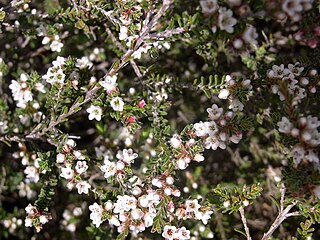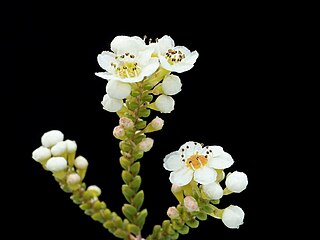
Thryptomene hexandra, commonly known as Palm Valley myrtle in the Northern Territory, is a species of flowering plant in the family Myrtaceae and is endemic to north-eastern Australia. It is an erect, much-branched shrub with linear to lance-shaped leaves and white flowers with six stamens.

Micromyrtus blakelyi is a species of flowering plant in the family Myrtaceae and is endemic to a small area near Sydney Australia. It is a low, cushion-like shrub with overlapping, keeled, linear leaves and small pink flowers arranged singly in upper leaf axils.

Micromyrtus ciliata is a species of flowering plant in the family Myrtaceae and is endemic to south-eastern continental Australia. It is a spreading to erect shrub with crowded, oblong to egg-shaped leaves and small white or pink flowers arranged singly in upper leaf axils, forming clusters on the ends of branches.
Micromyrtus barbata is a species of flowering plant in the family Myrtaceae and is endemic to inland areas of Western Australia. It is a shrub with small, overlapping, narrowly egg-shaped leaves and small white flowers arranged singly in upper leaf axils.
Micromyrtus fimbrisepala is a species of flowering plant in the family Myrtaceae and is endemic to inland Australia. It is a shrub with overlapping, broadly elliptic to more or less round leaves and small pink flowers arranged singly in upper leaf axils.

Micromyrtus flaviflora is a species of flowering plant in the myrtle family, Myrtaceae and is endemic to inland areas of Australia. It is an erect shrub with overlapping, keeled, oblong leaves, and yellow flowers arranged singly in leaf axils, but often appearing clustered.
Micromyrtus helmsii is a species of flowering plant in the myrtle family, Myrtaceae and is endemic to inland areas of Australia. It is a slender, erect or spreading shrub with overlapping, decussate, oblong leaves, and flowers with about 7 stamens, arranged singly in leaf axils.
Thryptomene biseriata is a species of flowering plant in the family Myrtaceae and is endemic to arid areas of southern central Australia. It is an erect, multi-stemmed shrub with more or less round to club-shaped leaves and pink flowers with five petals and five stamens.
Thryptomene elliottii is a species of flowering plant in the family Myrtaceae and is endemic to southern central Australia. It is a shrub with decussate, egg-shaped to club-shaped leaves and pink or white flowers with five petals and five stamens.
Thryptomene naviculata is a species of flowering plant in the family Myrtaceae and is endemic to central areas of Western Australia. It is a rounded shrub with overlapping, decussate, egg-shaped leaves with the narrower end towards the base and white flowers with five petals and five stamens.
Thryptomene nealensis is a species of flowering plant in the family Myrtaceae and is endemic to central areas of Western Australia. It is a shrub with overlapping, decussate, linear leaves and pink flowers with five petals and usually five stamens.

Thryptomene parviflora is a species of flowering plant in the family Myrtaceae and is endemic to Queensland. It is a slender, erect shrub with decussate, linear to egg-shaped leaves with the narrower end towards the base, and flowers with five petals and five stamens arranged singly in leaf axils.
Thryptomene remota is a species of flowering plant in the family Myrtaceae and is endemic to the northern part of the Northern Territory. It is an erect shrub with linear to lance-shaped leaves with the narrower end towards the base, and white or cream-coloured flowers with ten stamens.
Micromyrtus albicans is a species of flowering plant in the myrtle family, Myrtaceae and is endemic to a small area of south-eastern Queensland. It is a slender shrub with overlapping, egg-shaped leaves and small white flowers.
Micromyrtus capricornia is a species of flowering plant in the myrtle family, Myrtaceae and is endemic to a small area of central eastern Queensland. It is a shrub with slightly drooping branchlets, overlapping, narrowly egg-shaped leaves and small white flowers.
Micromyrtus carinata is a species of flowering plant in the myrtle family, Myrtaceae and is endemic to a small area of south-eastern Queensland. It is a slender shrub with drooping branchlets, overlapping, egg-shaped to lance-shaped leaves and small white flowers arranged singly in leaf axils.

Micromyrtus delicata is a species of flowering plant in the myrtle family, Myrtaceae and is endemic to a small area of northern coastal Queensland. It is a shrub with overlapping, linear to narrowly egg-shaped leaves with the narrower end towards the base and small white flowers arranged singly in leaf axils.
Micromyrtus forsteri is a species of flowering plant in the myrtle family, Myrtaceae and is endemic to a small area of north Queensland. It is a shrub with overlapping, linear to egg-shaped leaves and small white flowers arranged singly in leaf axils with 10 stamens in each flower.
Micromyrtus gracilis is a species of flowering plant in the myrtle family, Myrtaceae and is endemic to central Queensland. It is a slender shrub with overlapping, egg-shaped leaves and white flowers arranged singly in leaf axils with 5 stamens in each flower.

Micromyrtus hexamera is a species of flowering plant in the myrtle family, Myrtaceae and is endemic to eastern Australia. It is a shrub with many drooping branches, egg-shaped leaves with the narrower end towards the base, and white to pink flowers arranged singly in leaf axils with 12 stamens in each flower.






